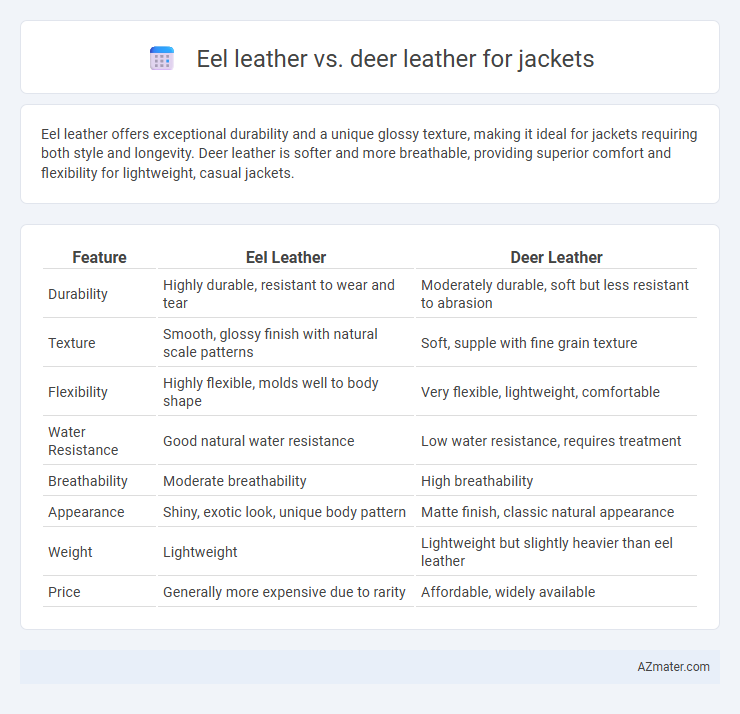Eel leather offers exceptional durability and a unique glossy texture, making it ideal for jackets requiring both style and longevity. Deer leather is softer and more breathable, providing superior comfort and flexibility for lightweight, casual jackets.
Table of Comparison
| Feature | Eel Leather | Deer Leather |
|---|---|---|
| Durability | Highly durable, resistant to wear and tear | Moderately durable, soft but less resistant to abrasion |
| Texture | Smooth, glossy finish with natural scale patterns | Soft, supple with fine grain texture |
| Flexibility | Highly flexible, molds well to body shape | Very flexible, lightweight, comfortable |
| Water Resistance | Good natural water resistance | Low water resistance, requires treatment |
| Breathability | Moderate breathability | High breathability |
| Appearance | Shiny, exotic look, unique body pattern | Matte finish, classic natural appearance |
| Weight | Lightweight | Lightweight but slightly heavier than eel leather |
| Price | Generally more expensive due to rarity | Affordable, widely available |
Introduction to Eel Leather and Deer Leather
Eel leather, known for its unique texture and exceptional durability, offers a lightweight yet strong alternative in jacket materials with a smooth, glossy finish that ages beautifully. Deer leather is prized for its softness, flexibility, and natural breathability, providing comfort and resilience suitable for rugged outdoor jackets. Both leathers present distinct advantages: eel leather excels in water resistance and longevity, while deer leather delivers superior comfort and a more natural, matte appearance.
Source and Sustainability of Materials
Eel leather is derived from freshwater and saltwater eel species, known for its smooth texture and durability, while deer leather comes from wild or farmed deer, valued for its softness and breathability. Eel leather offers a sustainable alternative by utilizing byproducts from the seafood industry, reducing waste and promoting resource efficiency. Deer leather sustainability depends on responsible wildlife management and ethical farming practices to ensure minimal environmental impact and biodiversity conservation.
Texture and Appearance Comparison
Eel leather offers a unique, glossy texture with a smooth, slightly bumpy surface resulting from its elongated scales, creating a sleek, modern appearance ideal for fashion-forward jackets. Deer leather features a soft, supple texture with a matte finish and natural grain patterns, providing a rustic and vintage look favored in classic and rugged jacket designs. The choice between eel and deer leather hinges on desired durability and aesthetic, as eel leather tends to be more water-resistant with a distinctive shine, while deer leather excels in flexibility and natural comfort.
Durability and Longevity
Eel leather exhibits exceptional durability and resistance to wear due to its unique fiber structure, making it ideal for jackets requiring long-lasting performance. Deer leather, while softer and more pliable, offers moderate durability but can develop a patina over time, enhancing its aesthetic appeal rather than its structural longevity. For jackets intended to withstand heavy use and environmental stress, eel leather provides superior longevity compared to the more delicate nature of deer leather.
Comfort and Flexibility
Eel leather offers exceptional softness and remarkable flexibility, making it highly comfortable for jackets by conforming easily to body movements without stiffness. Deer leather, while durable and breathable, tends to be thicker and less supple, which can reduce overall comfort and restrict flexibility compared to eel leather. For those prioritizing a lightweight, pliable jacket, eel leather provides superior comfort and easy wearability over the more rigid feel of deer leather.
Weight and Thickness Differences
Eel leather is significantly lighter and thinner compared to deer leather, making jackets crafted from eel leather more flexible and comfortable for extended wear. Deer leather is thicker and denser, providing enhanced durability and better insulation but often at the cost of added weight. The choice between eel and deer leather jackets depends largely on the preference for a lightweight, supple feel versus a rugged, heavier material with increased protection.
Care and Maintenance Requirements
Eel leather requires careful handling due to its delicate surface and is best maintained with regular conditioning to preserve its flexibility and prevent cracking. Deer leather is more durable and naturally water-resistant, needing less frequent conditioning but still benefits from occasional moisturizing to maintain softness and prevent drying. Both materials should be stored in a cool, dry place away from direct sunlight to extend the jacket's lifespan.
Price Comparison: Eel vs Deer Leather Jackets
Eel leather jackets typically cost more than deer leather jackets due to the intricate tanning process and the rarity of eel skin, which enhances their unique texture and durability. Deer leather jackets are generally more affordable, offering softness and breathability at a lower price point, appealing to budget-conscious consumers. Price differences between eel and deer leather jackets can range from 20% to 50%, depending on brand, quality, and craftsmanship.
Fashion and Style Versatility
Eel leather offers a sleek, glossy finish with natural texture variations, providing a distinctive look that elevates fashion-forward jackets with a modern edge. Deer leather is known for its soft, supple feel and matte finish, lending jackets a classic, rugged appeal that adapts seamlessly from casual to sophisticated styles. Both materials bring unique style versatility, with eel leather excelling in statement pieces and deer leather offering timeless comfort and durability.
Choosing the Best Leather for Jackets
Eel leather offers exceptional durability and a distinct, glossy texture ideal for fashion-forward jackets, while deer leather provides superior softness and flexibility, enhancing comfort and breathability. When choosing the best leather for jackets, consider eel leather for a unique, resilient finish that ages gracefully, whereas deer leather suits those seeking lightweight, supple wear with natural stretch. Both leathers deliver excellent insulation and longevity, but the decision hinges on whether style and durability or comfort and flexibility are prioritized.

Infographic: Eel leather vs Deer leather for Jacket
 azmater.com
azmater.com